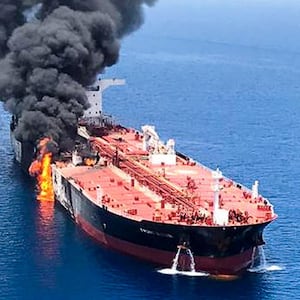Welcome to Rabbit Hole, a breaking-news analysis that helps you get smart on the one story everyone’s obsessing over—for Beast Inside members only.
The Trump administration wants to cut Iran’s supreme leader and his generals off from their stashes of illicit cash, but there’s just one problem: They’re already sanctioned to kingdom come and have been for years.
With so many sanctions already in effect, Monday’s announcement of new sanctions against the Islamic Revolutionary Guard Corps (IRGC) and Ayatollah Ali Khamenei are basically the financial equivalent of making the rubble bounce. So why did the Treasury Department do it? And what does it say about the Trump administration’s evolving response to Iran’s campaign of harassment in the Gulf?
ADVERTISEMENT
Welcome to Rabbit Hole.
Cash rules every ayatollah around me: In Monday’s sanctions announcement, Trump went after Iran’s supreme leader, Ayatollah Ali Khamenei. What’s the ayatollah worth? Reuters crunched the numbers in 2013 and found that, at least as of six years ago, Khamenei controlled an organization valued at $95 billion through the Execution of Imam Khomeini’s Order, or Setad, as it’s abbreviated in Persian.
A chart of Setad holdings put together by the U.S. Treasury Department shows a sprawling web of companies in construction, real estate, oil, and finance spread across Iran, the United Arab Emirates, Germany, South Africa, and Croatia. Those looking for Vladimir Putin-style luxury watches and expansive villas may come up empty. Experts say Khamenei’s lifestyle is hardly ascetic but the propaganda accounts of his relatively modest spending habits are more or less on the mark.
Instead, Khamenei’s multibillion-dollar empire appears to be more about power than comfort. Cash is king in politics and Iran is no exception. After the Iran-Iraq war, the IRGC got into the reconstruction business, which turned into a ballooning commercial empire tended to by Iran’s top military commanders. Today, the IRGC enjoys an outsize role in Iran’s non-military economy, which has led to increasing political clout for the Guards and their political priorities. If Khamenei—or any other future supreme leader—wants to make sure that the institution of clerical leadership maintains a grip on politics, it’s handy to have a piggybank like Setad.
Summer reruns: The list of Iranian military and political leaders sanctioned sure sounds impressive and aggressive, but there’s nothing in Monday’s sanctions designations that’s particularly new. The U.S. first sanctioned the IRGC over a dozen years ago in the waning years of President George W. Bush’s second term over its ballistic missile activity. President Obama sanctioned the IRGC in 2011 over its human rights abuses during the 2009 protests against the contested election of former president Mahmoud Ahmadinejad. Under the Obama administration, the Treasury Department sanctioned the supreme leader’s Setad piggybank in 2013. President Trump also sanctioned the IRGC and designated it as a foreign terrorist organization in April.
In other words, the federal government already had ample authority based on the executive orders of three presidents to go after any assets held by all of the Iranian leaders identified in Monday’s designation. Moreover, the new sanctions announcement didn’t reveal any new assets of Iran’s leadership that the U.S. could seize or block.
Org chart: The full text of the sanctions designation also reads like an organizational chart of the IRGC. The Guards have separate branches—the Ground Forces, which handles infantry operations, the Aerospace Force, which owns Iran’s strategic missile arsenal, and the IRGC Navy, which is responsible for Iranian military operations in the Persian Gulf. The IRGCN divides command and control of operations in the Persian Gulf among five districts from the Strait of Hormuz all the way up to the border with Iraq. IRGCN’s district commanders aren’t necessarily high-profile officers along the lines of the branch commanders, but the Trump administration sanctioned all of them—likely a reflection of the U.S. anger at tanker attacks in the Gulf of Oman and the shootdown of a U.S. Navy drone.
Pulled punches: So what’s the point in sanctioning top Iranian military and political leaders who are already fairly well covered by previous sanctions? The U.S. finds itself in a similar position as Iran. Tehran’s leaders felt they couldn’t take the Trump administration's recent ratcheting up of sanctions sitting down but didn’t want to attack the U.S. and invite a military reprisal. They (allegedly) found a sweet spot in actions just shy of that: shooting down American drones, disabling oil and petrochemical tankers of U.S. allies with limpet mines, and carrying out warning shot mortar attacks near and on U.S. military and diplomatic facilities.
Ever since the Trump administration declared an increased threat from Iran and rushed new troops, planes, and ships to the Gulf, it has struggled to find a strategy to deal with the uptick in Iranian mischief. The U.S. could easily pull off a conventional strike against just about any Iranian target of its choosing, but that would risk triggering a round of small scale reprisal attacks against American interests across the Middle East. President Trump appeared to acknowledge as much when he called off a series of strikes on Iranian air defenses last week in retaliation for the downing of a U.S. drone.
Sanctions may be part of America’s retaliatory own sweet spot to lash out without racking up a body count and kicking off a broader war. A number of news outlets reported that the intelligence community opted to hack Iranian missile command and control systems in lieu of a physical strike on them after the drone incident.






